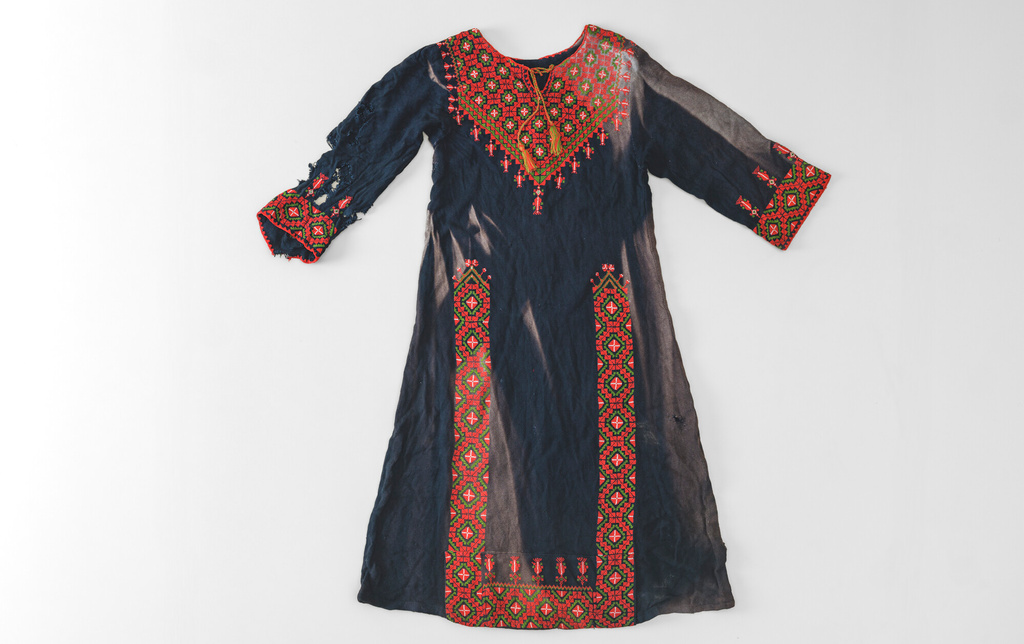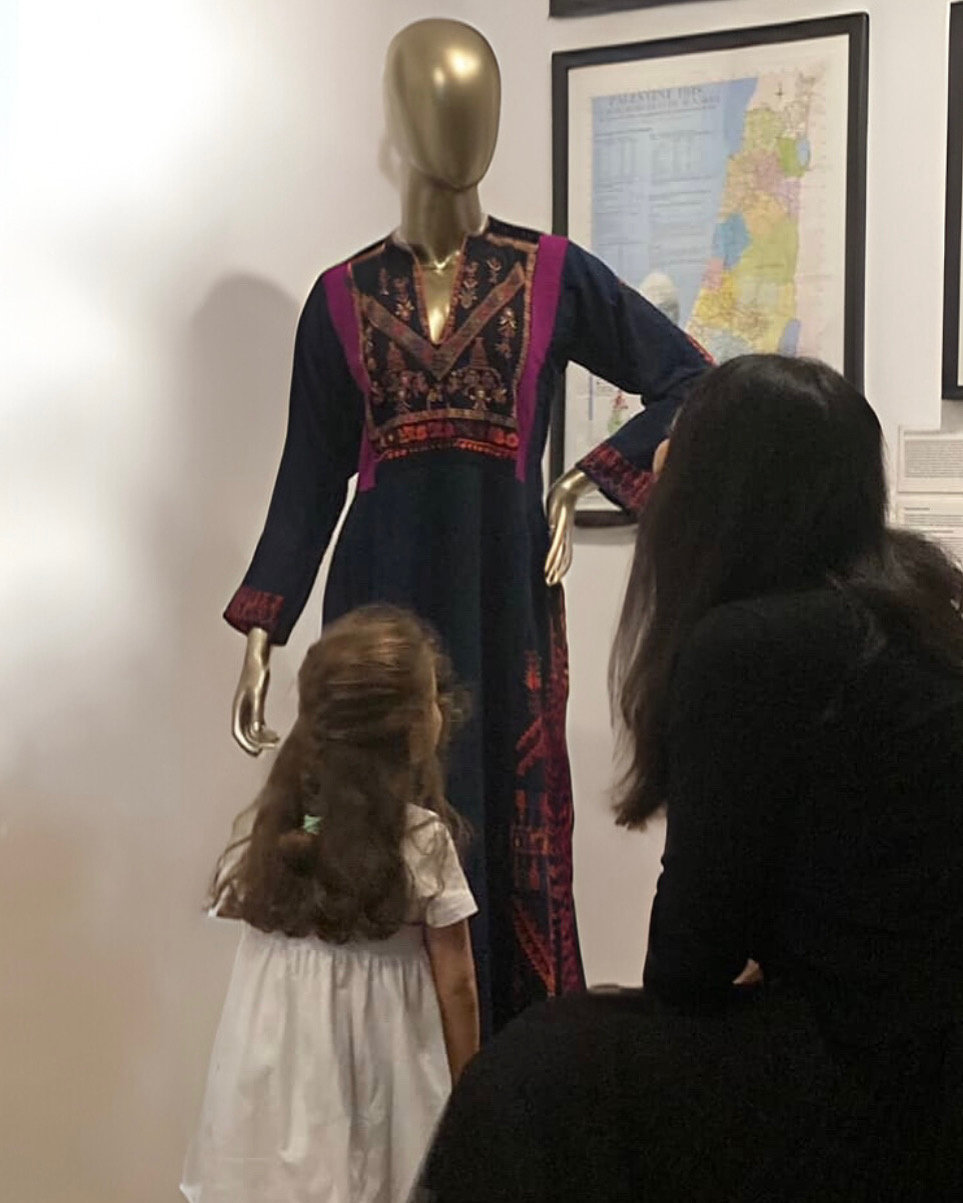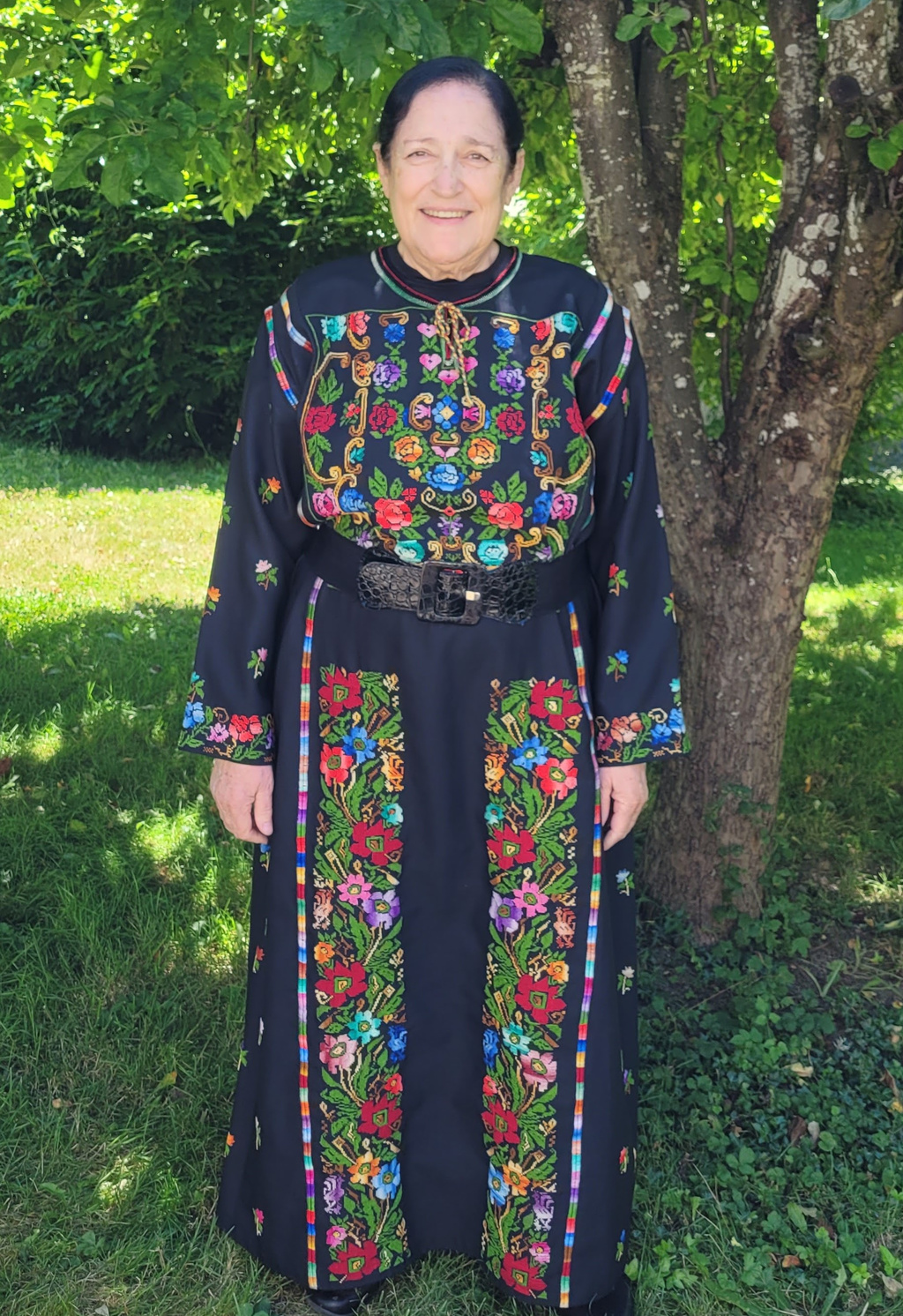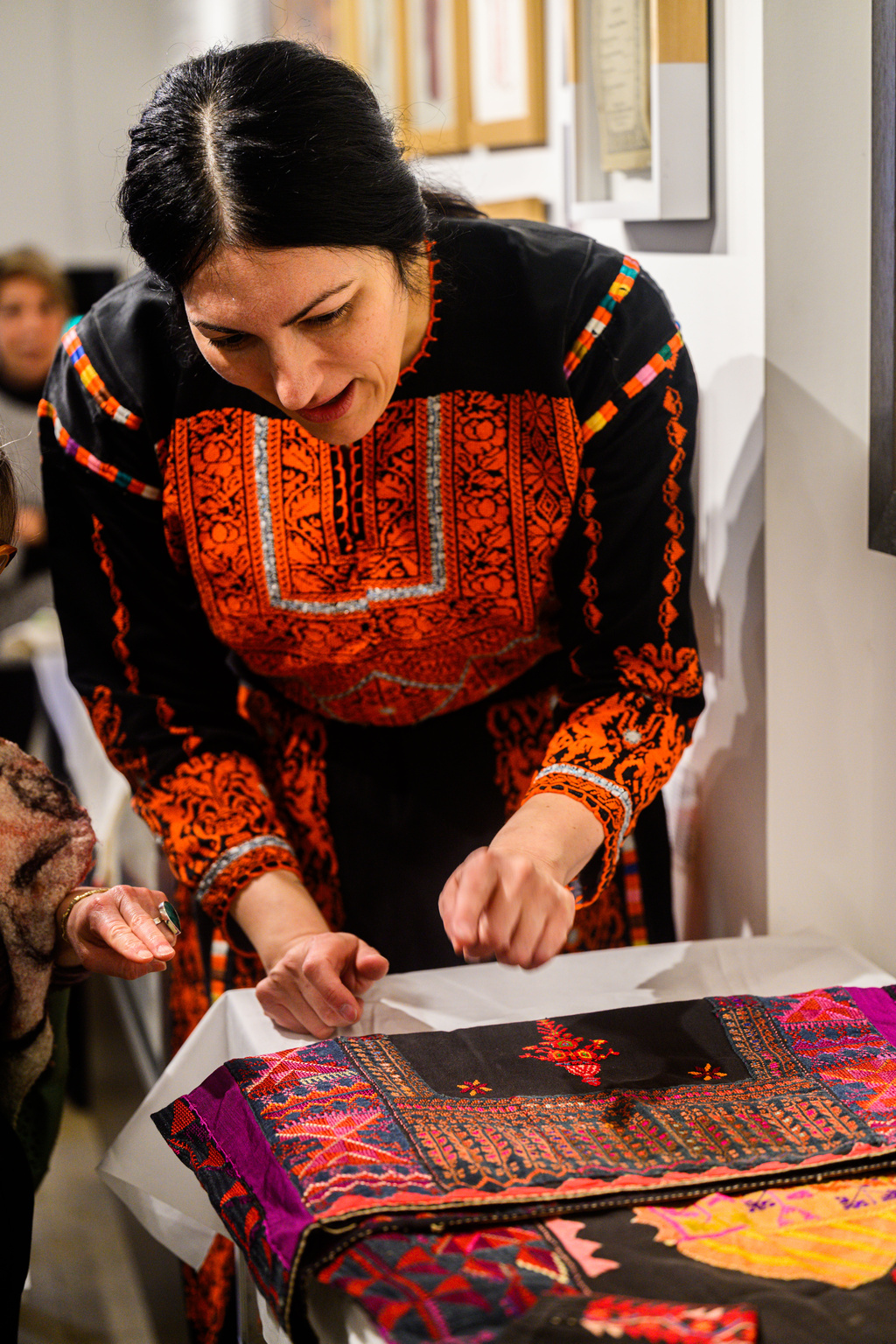
Thobe from Gaza, 2000-2010, Rafah Museum Collection, photo by Grant Anderson for V&A Dundee; copyright – Grant Anderson / www.grantanderson.me / @grantandersondotme
Wafa Ghnaim, a Palestinian dress historian, reflects on the role tatreez embroidery played in her upbringing and hopes diaspora heirlooms will eventually return to Palestine.
“When the dresses arrived, we took them out of the plastic bag and laid them on a big table. It looked like a morgue with a family of three bodies lying on the table.”
Amer Somali
On June 1, Garland Magazine published “Three Dresses Rescued from Rafah: Palestinian Culture Hangs by a Thread,” an article that explored the state of Palestinian dress and embroidery today. Through three museum collections–Rafah Museum, the Palestinian Museum, and the Victoria & Albert Museum–as well as the embroidery cooperative Sunbula in Jerusalem, the article documents the endangerment and survival of Palestinian embroidery amidst Israel’s ongoing genocide of Gaza. It invites further inquiry into the essential interdependence between heritage preservation and the material conditions of Palestinian life.
The state of our cultural heritage reflects, and is contingent upon, the treatment of Palestinian bodies, families, and communities. As the embroidery cooperative Sunbula affirms in their dispatch, the current state of embroidery, or tatreez, mirrors that of the people: both are endangered. As I build a study and research collection of Palestinian dresses through my educational initiative, the Tatreez Institute in Washington, DC, this article underscored the responsibility of diaspora culture workers to pursue preservation through an ethical framework that prioritizes the living stewards of the culture. Palestinian embroidery is inherently embodied; it is created by and for people. In Palestinian dress, or the thobe, the embroiderer and wearer were historically one in the same–and in her absence, the meaning of tatreez is fundamentally diminished. Without life, there are no stories. Without life, there is no tatreez.
As Rachel Dedman illuminates in the same article, there are many layers of meaning that embroidery holds for those living in Palestine and for members of the diaspora like me. She demonstrates that Palestinian creative expression is not static but dynamic, shaped by changing geopolitical realities and diasporic negotiations of identity as expressed through fabric, needle, and thread. In other words, tatreez continues to be used as a language for life. Sometimes, in unexpected ways.
Contemporary production methods, such as machine embroidery, are frequently critiqued as undermining authenticity. The distinction between handmade and machine-made embroidery must be analyzed through their respective capacities to facilitate cultural continuity, adaptation based on material circumstances, and community cohesion across borders. Acts of preservation by all Palestinians serve as affirmations of embodied identity and transgenerational resilience. The role of machine embroidery preserves a centuries-old relationship that allows Palestinian women of all economic backgrounds to wear the thobe. These practices constitute a vital cultural inheritance that will be left for and built upon by the next generation of Palestinians. As a whole, the three accounts of Amer Shamali, Sunbula, and Rachel Dedman must be read as both a documentation and a provocation, prompting critical discourse on the ethics of cultural preservation during extraordinary violence, especially in Gaza: the tragic human toll, the eradication of entire family lineages, the dismemberment of bodies, and the obliteration of institutions, ecosystems, and everything meaningful to life itself.

The author teaches Palestinian embroidery from a traditional Palestinian thobe from Gaza on display at the Museum of the Palestinian People, in Washington, DC. Photograph courtesy of the author.
Amer Shomali’s account of the three rescued dresses following the Rafah Museum explosion on October 28, 2023, is harrowing, historic, and profoundly grounding for my own practice.
She used to say that Palestinian words could be distorted, erased, or denied, but “not my thobe. My thobe doesn’t lie”
As a Palestinian collector, educator, dress historian, museum worker, and embroiderer based in the United States, I learned Palestinian embroidery from my mother, Feryal Abbasi-Ghnaim. Displaced by the 1948 Nakba, my mother raised my sisters and me with the stories of dispossession that led to and sustained our exile. My mother was also a historian, telling the centuries-old histories that describe tatreez as a medium of storytelling among women across millennia. These stories have defined my experience of being born and raised far from my homeland, shaping our family’s contemporary consciousness. My mother taught us tatreez as a form of intergenerational storytelling and cultural survivance, one that speaks of loss, belonging, and historical memory. She used to say that Palestinian words could be distorted, erased, or denied, but “not my thobe. My thobe doesn’t lie”— a truth that still holds today.

The author’s mother, Feryal Abbasi-Ghnaim, wears the Garden’s dress, a traditional Palestinian garment that she embroidered with Wafa and her sisters. Photograph courtesy of the author.
Over the past decade, I have devoted my professional and scholarly life to preserving and transmitting Palestinian embroidery techniques and dress history for future generations. I have taught thousands of Palestinians across the United States, Canada, and beyond. My work encompasses numerous areas: the publication of books and interpretive materials grounded in both oral history and academic research; partnerships with museum collections across North America to improve the cataloging and representation of Palestinian dress; and the development of an expanding collection of embroidered garments and headdresses through the Tatreez Institute. In many ways, my life’s work has been an effort to uncover and carry forward the historical truths encoded in each thobe that my mother shared with me in childhood. The identities and lived experiences of Palestinian women are embedded in the material details of the thobe, as well as in the condition each dress arrives in when it reaches my hands.
Many have wept when parting with a dress, recounting their efforts to preserve it over decades
This collection consists primarily of garments donated by former American diplomats, government employees, humanitarian aid workers, vintage shop owners, international tourists, and Palestinian peers and elders. While the study collection provides a foundation for material analysis, it is also deeply relational. I am spiritually connected to these dresses and their absent makers through each decisive stitch, evidence of lives once lived, bodies once fashioned. Though I attempt to discern the identity of the maker through technique and color, the truth remains: any personal meanings or memories she inscribed into her embroidery have been irretrievably lost. As I search for traces of her life, I am also confronted with signs of the donor’s choices and care. Often, their care is evident. Not once has a donor approached the act of giving with indifference. Many have wept when parting with a dress, recounting their efforts to preserve it over decades in the hope that it might one day be restored to its rightful cultural and historical context.
I once described my work as “rescue.”
However, every day since October 7, 2023, I have asked myself: What does it mean to “save” or “rescue” a dress when families, villages, and histories are being systematically destroyed? What was I really rescuing, if I could not help my people? What constitutes ethical stewardship under such conditions? How do our preservation efforts in the diaspora relate and impact the greater cause for Palestinian liberation?
My hope is that I am making a positive impact through my work, though I am still deeply unsettled by the knowledge that Palestinian life is often only deemed valuable when the makers have long passed, and their names are no longer known. Most North American museums carry collections of Palestinian dress that have not been exhibited for the past 75 years. Can you recall the last major American museum exhibition of Palestinian dress in your lifetime? I cannot. Most recently, me and my sisters curated a small exhibition for my mother’s birthday, her first solo show, to celebrate her life’s work. My mother is a National Endowment for the Arts Heritage Fellow, the first Palestinian woman to receive this lifetime achievement award. In the exhibition, we intended to both honor her as the known living maker of the embroidery on display, and as her daughters, to demonstrate how we have inherited her cultural knowledge and will continue to carry it forward. We shared her stories and teachings through the embroidery she created, presenting her legacy before her eyes. In the United States, there are few spaces that recognize and celebrate Palestinian elders, especially women, by name, let alone by the dresses they made and wore.
The rescued dresses of Gaza were a family of dresses, but without the family. Two of the garments belonged to adult women, the third to a child. We have no way of knowing the lineage of the dresses, who made them, or why they were on display, unless that information has been publicly documented and shared. The absence of names and personal histories deepens the sense of loss embedded in the gunpowder found on the dresses: a family of dresses without a person or place to return to, a collection of dresses without the Rafah Museum to care for them. The adult dresses were ripped to shreds. One appears torn at the neckline and hem, while the other is covered in soot and dust; each a reminder that both were impacted by the same explosion that separated the child’s dress from the rest.
And the child’s dress, in particular, has captivated me. She (the child’s dress) appears sunlit, as if the child who once wore it stands before us, still illuminated in the sun. The bleached streaks in the fabric are a result of sun exposure. For nearly a year, the dress lay atop the remains of a collapsed building, unreachable after the explosion that carried it into the air. The blue sky that was once full of birds and clouds as children played, has been made ominous and unpredictable by the relentless Israeli and American bombs raining on families, playgrounds, and schools. Amer Shomali recounts, “The last one was a dress for a little girl, which was blown up into the sky and landed on top of a destroyed building nearby. But no one could manage to get up to the roof to get it until almost a year later.” By the time it was retrieved, the dress had been bleached by the sun, pierced with holes, and caked with gunpowder. It bears all the signs of life and death in Gaza.
In every image, and now in the exhibition space of Thread Memory in V&A Dundee, the dress appears permanently sunlit. At first glance, the photograph looks as though the sun is shining onto the dress from a window, where the dress was photographed. Its discoloration is a lasting feature, though light continues to fall from the upper left-hand corner of the frame (see first photo in this article). The dress reflects the violence of war and the absence of the child who was meant to wear it, yet simultaneously affirms the childlike presence in the still colorful stitches that remain. The thobe stands in for the lives of all Palestinian children–reduced to numbers, yet each one singular and beloved. Each child represents an entire world. A family of dresses, absent the family. Embroidery rescued, while people are murdered on our phone screens. My question remains: why have we been unable to stop the genocide?
I find myself between the space of what renders me speechless, and yet what still must be said. I do not claim to hold all the answers to the questions presented in this essay, nor have I exhausted critique of my own work. But I am certain of one thing: all rescued dresses must return to Palestine one day. Altogether, and with my people. As Palestinian elders have taught us, when it comes to the future, we must remain committed to holding the view of the long horizon.
About Wafa Ghnaim
Wafa Ghnaim is an art and dress historian, fashion researcher, embroiderer, educator, and the founder of the Tatreez Institute, dedicated to the preservation of traditional dress in Palestine, Syria, Jordan, and Lebanon. She is the author of Tatreez & Tea (2016) and THOBNA (2023), with research published by the Metropolitan Museum of Art, the Art Institute of Chicago, and the National Gallery of Singapore. Her previous appointments include serving as an instructor at the Smithsonian, a Research Scholar at the Metropolitan Museum of Art, and a curator at the Museum of the Palestinian People. She currently continues her preservation work as a Mellon Foundation Research Fellow at the Museum of the Palestinian People.


